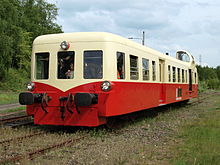SNCF X 3800
| SNCF X 3800 | |
|---|---|
|
X 3800 series museum car at the Chemin de fer du Haut Forez
|
|
| Numbering: | X 3801 to X 4051 |
| Number: | 251 |
| Manufacturer: | Régie Renault / ANF / De Dietrich / SACM |
| Year of construction (s): | 1950-1960 |
| Retirement: | 1988 |
| Axis formula : | B'2 ' |
| Gauge : | 1435 mm ( standard gauge ) |
| Length: | 21.851 m |
| Height: | 3,952 m |
| Width: | 3,090 m |
| Trunnion Distance: | 14,201 m |
| Service mass: | 31.5 t |
| Top speed: | 120 km / h |
| Traction power: | 250 kW |
| Motor type: | Saurer BZDSe or Renault |
| Power transmission: | mechanically |
| Seats: | 62 |
The "Autorails" of the X 3800 series, nicknamed "Picasso" or "300 CV", were diesel multiple units of the French state railway Société Nationale des Chemins de Fer Français (SNCF). Because of their tower-like elevated cab, they are among the most distinctive vehicles that drove on the French rail network in the second half of the 20th century. At times the railcars came across the French border to Saarland to Saarbrücken central station .
history
The four-axle diesel-mechanical railcars were built in 251 copies. Developed in 1947, they went into operation between 1950 and 1961. In 1988 the last but one were taken out of service by the SNCF, but 36 wagons are preserved at museum railways.
The commissioning of the vehicles went hand in hand with the SNCF series X 5500 and X 5800 ("Mobylettes" or "150 CV"), which were built at the same time, as well as another series, the SNCF series X 2400 with 600 hp. After the Second World War, the SNCF's pre-war vehicle fleet of rail buses and combustion railcars was fundamentally renewed with three uniform series of different performance classes. These combustion railcars also made it easier to replace the steam traction .
Manufacturer
At the assembly were under the direction of Renault and the company Ateliers de construction du Nord de la France (ANF), De Dietrich and SACM involved. The engines came partly from the Swiss company Saurer , partly from Renault.
features
A special characteristic is the low-lying wagon floor as we know it today (as of 2012) from low-floor vehicles (for example the DB series 641 and the structurally identical SNCF series X 73500 and X 73500). This was made possible by mounting the motor on one end of the car above the bogie; In this area there is also a luggage compartment and directly above the characteristic driver's cab. This arrangement simplified the operation - the clutch and the mechanical four-speed gearshift could act directly on the transmission underneath the driver without major deflections - but made it difficult to see the area in front of the vehicle, especially at the more distant end.
The entry for travelers is in the low-floor area. The passenger compartment, a large room with a central aisle in face-to-face seating, has a 2 + 3 seating arrangement in 2nd class and 2 + 2 seating arrangement in 1st class. It is located between the bogies and above the non-powered bogie. Since the only driver's cab in a raised cockpit was only at one end of the car sideways above the engine, the seats above the non-motorized bogie had a profiled arrangement. The last row of seats was located directly at the end of the vehicle and was also aligned towards the end of the vehicle. It enabled a clear and unobstructed view of the railway line through a window at the end of the vehicle.
This form with only one driver's cab, which was raised in a pulpit, also shaped the series X 5500 and X 5800 Mobylettes, which were built from 1950 to 1954. The nickname “Picasso” arose from the one-sided, off-center arrangement of the driver's cab above the vehicle, which disrupted the design and was reminiscent of the surrealistic portraits of Pablo Picasso .
There were two versions of the passenger seats. The two-class offered 20 places in the 1st class, 32 in the 2nd class and 6 folding seats , the single-class 62 places in the 2nd class and 5 folding seats.
With its standard couplings, the railcar could be connected to other SNCF vehicles without restriction.
literature
- José Banaudo: Les Autorails unifies de 300 CV X 3800. Editions du Cabari, Breil / Roya 1997, ISBN 2-908816-53-9 .
Web links
Individual evidence
- ↑ Flyer railcar X 3800 Picasso of the SNCF. In: Encyclopedia of the Railways. Atlas Verlag, 1996.
- ↑ railways in Saarland State at saar-nostalgie.de, accessed on August 2, 2018
- ^ Restoration of car X 3890 at the Chemins de fer du Center Bretagne


